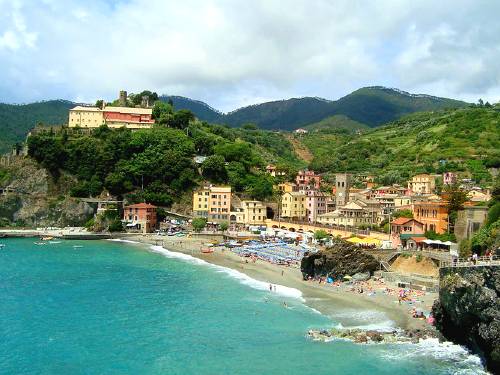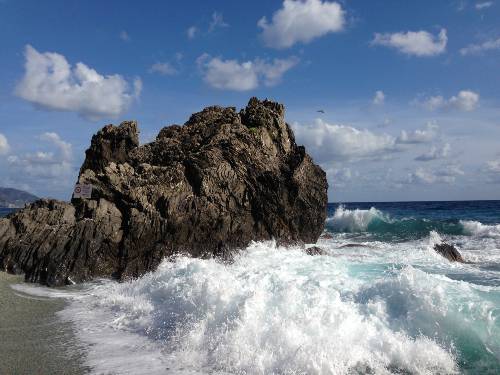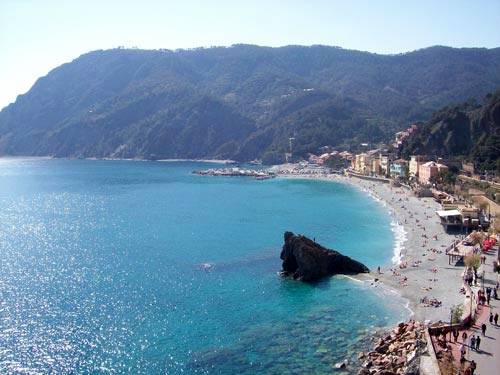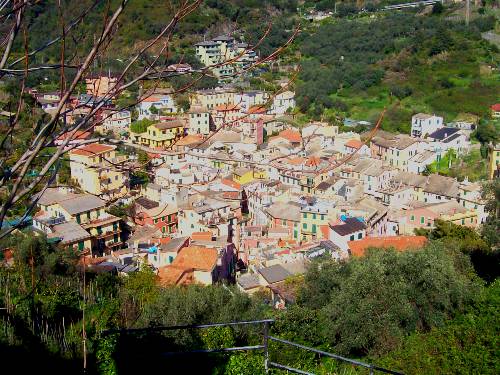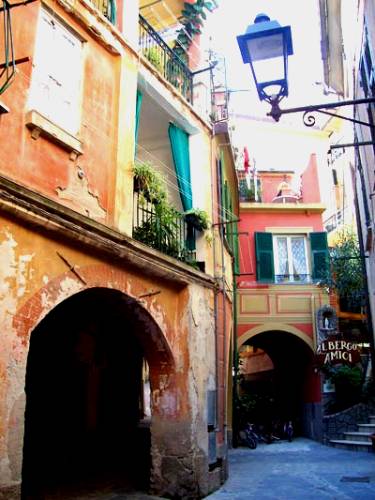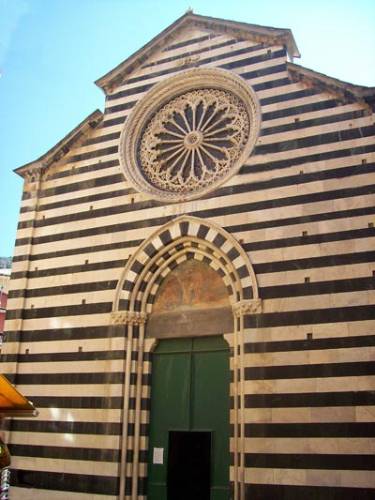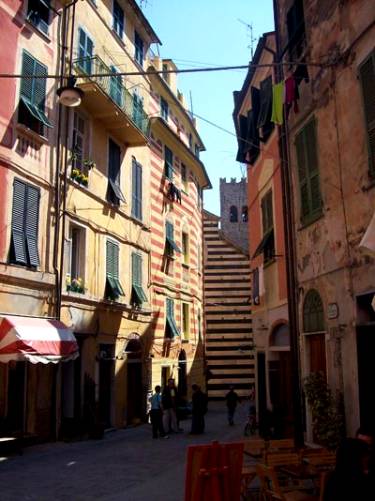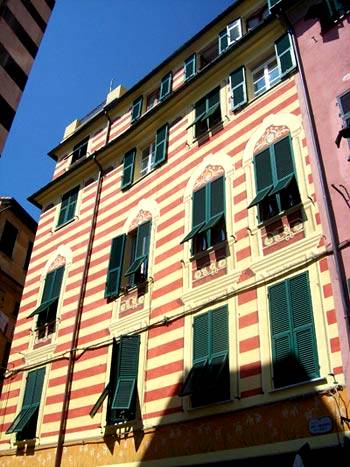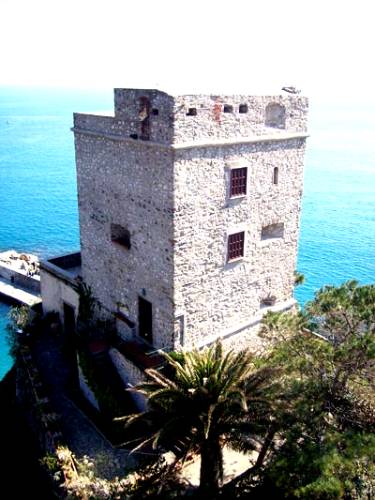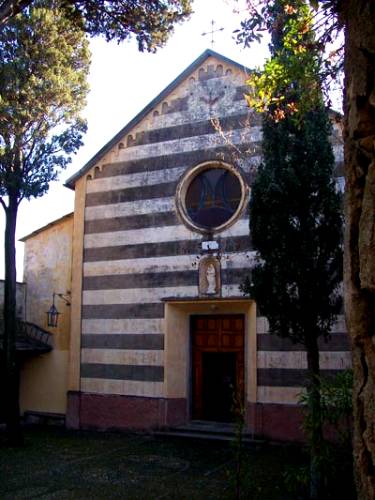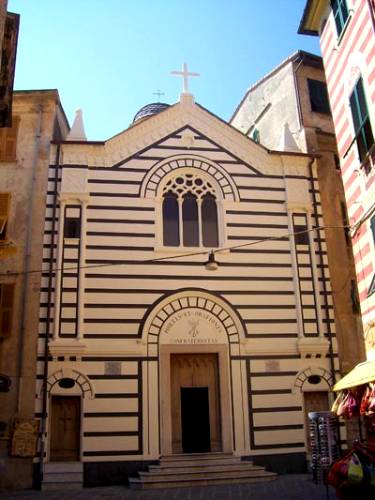Monterosso information index:
- History
- What to see
- Where to sleep
- Where to eat and restaurants
- Beaches
- Trekking
- Gastronomy
- Traditional holidays
- How to get there
- Weather forecast
Reading time: 6 minutes. Does it seem too much?
Monterosso al Mare is the first of the Cinque Terre coming from the west and is also the most populated, enclosed between Punta Mesco and Punta Corone. The town is divided into two parts, to the east the residential area of Fegina, with the famous beach, the promenade and the train station; to the west, separated from the hill of San Cristoforo or dei Cappuccini, the old town, the small port where boats dock and the sandy beach. The oldest part is located just above the hill that divides the two parts, where the castle once stood, now a municipal cemetery, in the valley of the Buranco stream.
History
A first medieval settlement is attested in the ninth century, built on the Capuchin hill. Shortly after the year 1000, the inhabitants began to descend into the natural inlet and the small town began to increase in number and was protected by walls by the Obertenghi. In the 11th century the fiefdom passed to the Fieschi di Lavagna, in the 12th century to the local family of the lords of Lagneto and then in the 13th century Monterosso entered the Genoese orbit, starting a progressive agricultural and commercial development. In 1545 the village was the victim of a terrible raid by Barbary pirates led by the Ottoman corsair Dragut. With the arrival of Napoleon, Monterosso followed the vicissitudes of French domination and the birth of the Kingdom of Italy.
What to see
The town is therefore divided into two parts, connected by a pedestrian tunnel or by a comfortable path that runs along the sea and the Aurora tower or by a more demanding route, the Salita dei Cappuccini, which climbs towards the convent and the cemetery and then descends again just beyond the tunnel exit. In the old part, Monterosso is characterized like the other lands, by the typical tower-houses painted with bright colors and the narrow alleys. All this, combined with the ease with which you can reach the town, the breadth of the beaches compared to the rest of the Cinque Terre and the greater size of the village, make it the most visited land.
The old town is a treasure trove of works of art, starting with the church of San Giovanni Battista, built between the end of the thirteenth century and the beginning of the fourteenth. With three naves, the typical façade is in Genoese Gothic style, with green and white bicrome marble bands from the Mesco quarries, with a beautiful central rose window. The medieval bell tower, erected as a guard and defense tower, was part of the defensive system of the village. Next to the church, overlooking the Don Minzoni square itself, is the oratory of the Confraternita dei Neri Mortis et Orationis, a Baroque building remodeled in 1922. Inside there are numerous stucco decorations and frescoes depicting skulls and skeletons. Walking through the alleys, you can also visit the oratory of Santa Croce, or dei Bianchi, from the 16th century, in Via Gioberti, where there are numerous ex-votos in favor or left by the sailors.
From the historic center, returning to the Fegina area, you can go up to the Capuchin convent, on the hill of San Cristoforo, where the church of San Francesco and the cemetery are also located. The convent complex dates back to the early 17th century and preserves beautiful paintings such as the Crucifixion attributed to the Flemish painter Antoon van Dyck, and the painting of San Girolamo penitente by Luca Cambiaso. The church is characterized by the typical façade with black and white horizontal bands. From here, continue to the cemetery, located in the area of the ancient castrum, where some parts of the fortifications remain in the highest part.
Continuing the visit towards the beach of Fegina, we come across the Torre Aurora, today a private residence, overlooking the sea, built by Genoa in the 16th century. Just below the tower there is a bunker from the Second World War.
The beach of Fegina now opens with its large rock. Walking along the promenade to the end, you reach the curious statue of the Giant Neptune, a large reinforced concrete structure, 14 meters high, leaning against a rock spur. The statue adorned Villa Pastine, along with a large shell-shaped terrace, which was damaged during World War II, when it also lost its arms, leg and trident.
Just above Monterosso, on the heights, stands the sanctuary of Nostra Signora di Soviore, already mentioned in documents from 1220, decorated with various cycles of frescoes. A place of peace, with breathtaking views, it is part of a larger complex that includes the bell tower, the portico and the guesthouse, immersed in the centuries-old holm oaks that surround them.
There are many monuments to visit in Monterosso, find out more in the section of what to see in Monterosso.
Where to sleep
Monterosso is the largest and most touristic town in the Cinque Terre. This is where the greatest number of hotels, b&b and rooms. Thera are some farmhouses in Monterosso, on the surrounding hills too.
Where to sleep in Monterosso
Where to eat and restaurants
The same can be said for the restaurants in Monterosso, numerous both in the Fegina area, on the seafront and in the residential area, and in the historic center. Countless bars and street food where to take a slice of pizza, focaccia, farinata or even an ice cream to be enjoyed while walking around.
Beaches
For those who want to cool off after or before visiting Monterosso, there are several possibilities. First of all, the long beach of Fegina, in the residential area, immediately accessible from the train station, almost all occupied by bathing establishments except for a free beach located just outside the station. Towards the statue of the Giant is the beach of Neptune, with a bathing establishment and a free beach; while in front of the historic center there is the sandy beach of Monterosso, as well with bathing establishment and a free beach towards Punta Corone. Here you will find more detailed information on beaches in Monterosso.
Trekking trails
For hikers, there are three main routes starting from Monterosso. The first is the blue path that leads from the town to Vernazza (592-4) in about 3 and a half kilometers; the second leads to the sanctuary of Soviore (509) following the historic mule track used for centuries by the monterossini; the third reaches the remains of the hermitage of Sant’Antonio del Mesco, towards Levanto, in just over an hour. Find out about all the trekking trails in Monterosso.
Gastronomy
Monterosso is famous for its typical wine, the sciacchetrà, a passito wine produced from the grapes of the terraces of the Cinque Terre, mainly with albarola, bosco and vermentino vines. Certainly to mention among the typical products are also lemons. On the third Saturday of May, the homonymous festival is celebrated, with which limoncino, lemon cream and jams are made. Anchovies from Monterosso, on the other hand, are famous because they are particularly firm and tasty. The fried anchovy festival takes place on the third Saturday in June, while the salted anchovy and olive oil festival takes place on the third Saturday in September.
Traditional holidays
The most traditional festivals of Monterosso take place mainly in spring and summer. In May the Festa dei limoni, lemon festival, takes place while in June the Corpus Domini is celebrated, with the procession through the streets of the town and the infiorata, flower carpet, the Fried anchovy festival and on June 24th for San Giovanni it is burned in the traditional bonfire, calles the Battiston, a rag puppet. On 7 July it is the feast of Our Lord of Soviore while in September the Salted anchovy festival is celebrated.
Here is the calendar of Monterosso festivals.
How to get there
The best means of transport to get to Monterosso is the train, along the La Spezia-Levanto line, with numerous trips during the summer. By car, the route becomes long and winding, whether coming from La Spezia, from Levanto after exiting the motorway or even from Pignone after exiting at Borghetto Vara. The Fegina car park, on the sea, is quite large even if it fills up quickly and the cost is quite high.
A third option is by ferry coming from the other vilalges except Corniglia.
Detailed information on how to get to Monterosso.
Weather forecast
Monterosso enjoys a temperate and mild climate during most of the year. In the warmer months, temperatures reach a maximum of 30 degrees, but the average settles at 22 degrees. The wettest months are October and November, although the rains are usually short-lived.
To find out the weather forecast for Monterosso and decide if it is the right day for a day at the beach, check the weather forecast for Monterosso.
